

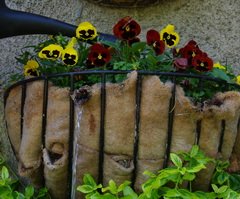
It is my firm belief that the many hours I spend in the garden growing gorgeous flowers and delicious vegetables make Mother Nature look even more wonderful. Why then does she find new ways to test and torment me. Ignore the fact that this issue of Dallying In The Dirt is late because I am scrambling to get the last of the garden planted now that we finally have a few days of warmth and sunshine after the great deluge of 2011. The wall planters have been growing great Pansies in the cool wet weather but they still need watering because the rain does not reach them. Watering the largest of them last week became a very irritating experience. The minute I started to pour water in, it started to pour out the front of the container. Somebody, I suspect the bushy tailed tree rats (aka. squirrels,) had taken great chunks of the coconut fibre liner to make their nest cozy. The result was no freeboard to hold the water. The liner was chewed down to the top of the soil and any added water just ran right off and down onto me. New on the job list. Cut some strips of coco liner and tuck it into the top of the planters so that they can be watered. Gardening is always an interesting challenge. 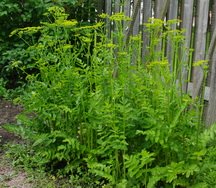 Now the push is on to finally get the last of the other little plants into the ground. Last years Parsnips are still in the bottom of the garden and are flowering magnificently. They should have been dug and eaten a month ago but they were almost underwater for much of that time. They are in the way of the wire trellising that the melons climb on. Like so much of what we do in the garden; this can’t be done until that is done first and that can’t be done for some external reason.
Now the push is on to finally get the last of the other little plants into the ground. Last years Parsnips are still in the bottom of the garden and are flowering magnificently. They should have been dug and eaten a month ago but they were almost underwater for much of that time. They are in the way of the wire trellising that the melons climb on. Like so much of what we do in the garden; this can’t be done until that is done first and that can’t be done for some external reason.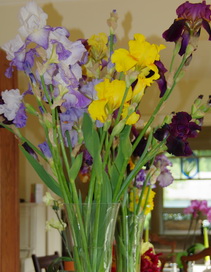 Lest you think that I’m no longer finding gardening a rewarding and therapeutic experience, let me tell you about my Iris. Despite being something of a high maintenance perennial they do remain my favourite and they have been magnificent this year. The cool and damp that I complain about in the annual garden has been truly beneficial in the Iris beds. Dozens of large flower stalks are presently in full bloom and I wander the garden each morning to see which new variety has bloomed and then declare that maybe it is my favourite. I admit to being somewhat of a competitive gardener and I gently trotted my best Iris blooms to the local Iris show and managed to get first prize ribbons in nine classes. Sadly the best in show trophy went elsewhere but it was a lovely bloom. One of the delights of showing my Iris is the magnificent bouquet that comes home to grace the kitchen counter for many days afterwards. Maybe I should apologize to Mother Nature for my previous, slightly negative, comments. I really shouldn’t take all the credit for the good things and blame her for all of the bad things. This is a partnership.
Lest you think that I’m no longer finding gardening a rewarding and therapeutic experience, let me tell you about my Iris. Despite being something of a high maintenance perennial they do remain my favourite and they have been magnificent this year. The cool and damp that I complain about in the annual garden has been truly beneficial in the Iris beds. Dozens of large flower stalks are presently in full bloom and I wander the garden each morning to see which new variety has bloomed and then declare that maybe it is my favourite. I admit to being somewhat of a competitive gardener and I gently trotted my best Iris blooms to the local Iris show and managed to get first prize ribbons in nine classes. Sadly the best in show trophy went elsewhere but it was a lovely bloom. One of the delights of showing my Iris is the magnificent bouquet that comes home to grace the kitchen counter for many days afterwards. Maybe I should apologize to Mother Nature for my previous, slightly negative, comments. I really shouldn’t take all the credit for the good things and blame her for all of the bad things. This is a partnership.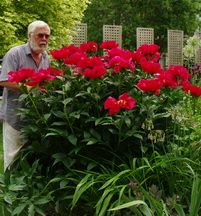 In between the Iris I do allow a few Peonies to grow and they have also been wonderful this year. A few of them opened during the very warm days that we had earlier, (not enough to dry the garden,) and seemed to last a very short time. My favourite Peony is a large single red variety, “America”. The plant in the picture has about 45 blooms on it and was planted at the front of the garden in 2003. It stops traffic on the road.
In between the Iris I do allow a few Peonies to grow and they have also been wonderful this year. A few of them opened during the very warm days that we had earlier, (not enough to dry the garden,) and seemed to last a very short time. My favourite Peony is a large single red variety, “America”. The plant in the picture has about 45 blooms on it and was planted at the front of the garden in 2003. It stops traffic on the road.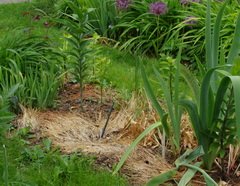 I must now turn my attention to the large quantities of “natural vegetation” (aka. weeds,) that have flourished in the cool damp weather. My inability to get out into the garden has also allowed them to grow to considerable size. It is much easier to hoe down a weed seedling than to excavate a large specimen but that seems to be this year’s chore. The upside is, there are fewer to pull and each one successfully removed, clears a satisfying area of soil. In one of the front beds there is a considerable quantity of grass like foliage turning yellow and looking very finished. I must dig it out this year. It is the fall blooming Crocus Kotschyanus and despite its great spring leaf growth it has never bloomed for me. Obviously the autumn weather in my little corner of the world is not to its liking. After several years of frustration it is clearly a non performer and its time has come.
I must now turn my attention to the large quantities of “natural vegetation” (aka. weeds,) that have flourished in the cool damp weather. My inability to get out into the garden has also allowed them to grow to considerable size. It is much easier to hoe down a weed seedling than to excavate a large specimen but that seems to be this year’s chore. The upside is, there are fewer to pull and each one successfully removed, clears a satisfying area of soil. In one of the front beds there is a considerable quantity of grass like foliage turning yellow and looking very finished. I must dig it out this year. It is the fall blooming Crocus Kotschyanus and despite its great spring leaf growth it has never bloomed for me. Obviously the autumn weather in my little corner of the world is not to its liking. After several years of frustration it is clearly a non performer and its time has come. Time to answer a few questions and then get back into the garden. If you have a gardening question just ‘reply’ to this newsletter and send me your query. I try to answer most of the questions and the ones that I answer here are those that I think will have the widest interest. You can also find the latest garden updates on the front page of gardening-enjoyed . Melissa Asks? The last couple of years, I have planted peas in my vegetable garden. The first year, they grew too tall and all fell over. The next year I used some stakes and provided some chicken wire for them to climb, and they just climbed a couple feet above the chicken wire and fell over above it. Last year, I put the chicken wire up higher, but it seems that no matter what, they are determined to just grow taller than whatever height chicken wire I use, and flop over, making it very difficult/impossible to pick peas without damaging the vines. Can I just provide a 30” high chicken wire, and pinch off the climbers, or will that damage the plants? I also think that with all that vining I am losing out on yield. Also, they don’t usually end up in the ground before the second half of May (we have young children and sometimes it just doesn’t happen earlier). I’m using a different variety this year, Sabre (William Dam Seeds), but have used two or three different ones in years past. |
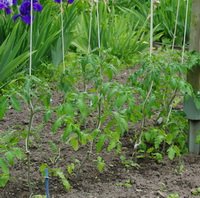 The
The 